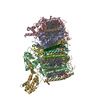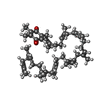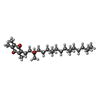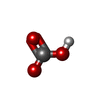[English] 日本語
 Yorodumi
Yorodumi- PDB-8kde: Cryo-EM structure of an intermediate-state complex during the pro... -
+ Open data
Open data
- Basic information
Basic information
| Entry | Database: PDB / ID: 8kde | ||||||||||||
|---|---|---|---|---|---|---|---|---|---|---|---|---|---|
| Title | Cryo-EM structure of an intermediate-state complex during the process of photosystem II repair | ||||||||||||
 Components Components |
| ||||||||||||
 Keywords Keywords | PHOTOSYNTHESIS / monomeric Photosystem II / PSII repair | ||||||||||||
| Function / homology |  Function and homology information Function and homology informationphotosystem II repair / oxygen evolving activity / photosystem II stabilization / photosystem II / photosystem II reaction center / oxidoreductase activity, acting on diphenols and related substances as donors, oxygen as acceptor / photosynthetic electron transport chain / response to herbicide / photosystem II / chlorophyll binding ...photosystem II repair / oxygen evolving activity / photosystem II stabilization / photosystem II / photosystem II reaction center / oxidoreductase activity, acting on diphenols and related substances as donors, oxygen as acceptor / photosynthetic electron transport chain / response to herbicide / photosystem II / chlorophyll binding / photosynthesis, light reaction / electron transporter, transferring electrons within the cyclic electron transport pathway of photosynthesis activity / phosphate ion binding / chloroplast thylakoid membrane / photosynthetic electron transport in photosystem II / photosynthesis / electron transfer activity / protein stabilization / iron ion binding / heme binding / membrane / metal ion binding Similarity search - Function | ||||||||||||
| Biological species |  | ||||||||||||
| Method | ELECTRON MICROSCOPY / single particle reconstruction / cryo EM / Resolution: 2.6 Å | ||||||||||||
 Authors Authors | Li, A. / Wang, Y. / Liu, Z. | ||||||||||||
| Funding support |  China, 3items China, 3items
| ||||||||||||
 Citation Citation |  Journal: Nat Commun / Year: 2024 Journal: Nat Commun / Year: 2024Title: Structural basis for an early stage of the photosystem II repair cycle in Chlamydomonas reinhardtii. Authors: Anjie Li / Tingting You / Xiaojie Pang / Yidi Wang / Lijin Tian / Xiaobo Li / Zhenfeng Liu /  Abstract: Photosystem II (PSII) catalyzes water oxidation and plastoquinone reduction by utilizing light energy. It is highly susceptible to photodamage under high-light conditions and the damaged PSII needs ...Photosystem II (PSII) catalyzes water oxidation and plastoquinone reduction by utilizing light energy. It is highly susceptible to photodamage under high-light conditions and the damaged PSII needs to be restored through a process known as the PSII repair cycle. The detailed molecular mechanism underlying the PSII repair process remains mostly elusive. Here, we report biochemical and structural features of a PSII-repair intermediate complex, likely arrested at an early stage of the PSII repair process in the green alga Chlamydomonas reinhardtii. The complex contains three protein factors associated with a damaged PSII core, namely Thylakoid Enriched Factor 14 (TEF14), Photosystem II Repair Factor 1 (PRF1), and Photosystem II Repair Factor 2 (PRF2). TEF14, PRF1 and PRF2 may facilitate the release of the manganese-stabilizing protein PsbO, disassembly of peripheral light-harvesting complexes from PSII and blockage of the Q site, respectively. Moreover, an α-tocopherol quinone molecule is located adjacent to the heme group of cytochrome b, potentially fulfilling a photoprotective role by preventing the generation of reactive oxygen species. | ||||||||||||
| History |
|
- Structure visualization
Structure visualization
| Structure viewer | Molecule:  Molmil Molmil Jmol/JSmol Jmol/JSmol |
|---|
- Downloads & links
Downloads & links
- Download
Download
| PDBx/mmCIF format |  8kde.cif.gz 8kde.cif.gz | 507 KB | Display |  PDBx/mmCIF format PDBx/mmCIF format |
|---|---|---|---|---|
| PDB format |  pdb8kde.ent.gz pdb8kde.ent.gz | 421.5 KB | Display |  PDB format PDB format |
| PDBx/mmJSON format |  8kde.json.gz 8kde.json.gz | Tree view |  PDBx/mmJSON format PDBx/mmJSON format | |
| Others |  Other downloads Other downloads |
-Validation report
| Summary document |  8kde_validation.pdf.gz 8kde_validation.pdf.gz | 3.6 MB | Display |  wwPDB validaton report wwPDB validaton report |
|---|---|---|---|---|
| Full document |  8kde_full_validation.pdf.gz 8kde_full_validation.pdf.gz | 3.7 MB | Display | |
| Data in XML |  8kde_validation.xml.gz 8kde_validation.xml.gz | 98.5 KB | Display | |
| Data in CIF |  8kde_validation.cif.gz 8kde_validation.cif.gz | 132.8 KB | Display | |
| Arichive directory |  https://data.pdbj.org/pub/pdb/validation_reports/kd/8kde https://data.pdbj.org/pub/pdb/validation_reports/kd/8kde ftp://data.pdbj.org/pub/pdb/validation_reports/kd/8kde ftp://data.pdbj.org/pub/pdb/validation_reports/kd/8kde | HTTPS FTP |
-Related structure data
| Related structure data |  37133MC M: map data used to model this data C: citing same article ( |
|---|---|
| Similar structure data | Similarity search - Function & homology  F&H Search F&H Search |
- Links
Links
- Assembly
Assembly
| Deposited unit | 
|
|---|---|
| 1 |
|
- Components
Components
-Photosystem II ... , 14 types, 14 molecules BDHIKLMTVZ3CA1
| #1: Protein | Mass: 56089.703 Da / Num. of mol.: 1 / Source method: isolated from a natural source / Source: (natural)  |
|---|---|
| #2: Protein | Mass: 39474.031 Da / Num. of mol.: 1 / Source method: isolated from a natural source / Source: (natural)  |
| #5: Protein | Mass: 9445.063 Da / Num. of mol.: 1 / Source method: isolated from a natural source / Source: (natural)  |
| #6: Protein/peptide | Mass: 4245.035 Da / Num. of mol.: 1 / Source method: isolated from a natural source / Source: (natural)  |
| #7: Protein/peptide | Mass: 5062.142 Da / Num. of mol.: 1 / Source method: isolated from a natural source / Source: (natural)  |
| #8: Protein/peptide | Mass: 4431.229 Da / Num. of mol.: 1 / Source method: isolated from a natural source / Source: (natural)  |
| #9: Protein/peptide | Mass: 3762.433 Da / Num. of mol.: 1 / Source method: isolated from a natural source / Source: (natural)  |
| #10: Protein/peptide | Mass: 3639.438 Da / Num. of mol.: 1 / Source method: isolated from a natural source / Source: (natural)  |
| #11: Protein/peptide | Mass: 3333.058 Da / Num. of mol.: 1 / Source method: isolated from a natural source / Source: (natural)  |
| #13: Protein | Mass: 6565.863 Da / Num. of mol.: 1 / Source method: isolated from a natural source / Source: (natural)  |
| #15: Protein | Mass: 13340.966 Da / Num. of mol.: 1 / Source method: isolated from a natural source / Source: (natural)  |
| #16: Protein | Mass: 50680.738 Da / Num. of mol.: 1 / Source method: isolated from a natural source / Source: (natural)  |
| #17: Protein | Mass: 39066.340 Da / Num. of mol.: 1 / Source method: isolated from a natural source / Source: (natural)  |
| #18: Protein | Mass: 12002.007 Da / Num. of mol.: 1 / Source method: isolated from a natural source / Source: (natural)  |
-Cytochrome b559 subunit ... , 2 types, 2 molecules EF
| #3: Protein | Mass: 9312.598 Da / Num. of mol.: 1 / Source method: isolated from a natural source / Source: (natural)  |
|---|---|
| #4: Protein/peptide | Mass: 4986.013 Da / Num. of mol.: 1 / Source method: isolated from a natural source / Source: (natural)  |
-Protein , 2 types, 2 molecules XG
| #12: Protein | Mass: 9894.716 Da / Num. of mol.: 1 / Source method: isolated from a natural source / Source: (natural)  |
|---|---|
| #14: Protein | Mass: 20601.596 Da / Num. of mol.: 1 / Source method: isolated from a natural source / Source: (natural)  |
-Sugars , 1 types, 3 molecules 
| #27: Sugar |
|---|
-Non-polymers , 11 types, 69 molecules 




















| #19: Chemical | ChemComp-CLA / #20: Chemical | ChemComp-BCR / #21: Chemical | ChemComp-LMG / #22: Chemical | ChemComp-LHG / #23: Chemical | ChemComp-PL9 / | #24: Chemical | #25: Chemical | ChemComp-HEM / | #26: Chemical | ChemComp-VTQ / | #28: Chemical | ChemComp-SQD / | #29: Chemical | ChemComp-BCT / | #30: Chemical | ChemComp-FE2 / | |
|---|
-Details
| Has ligand of interest | Y |
|---|
-Experimental details
-Experiment
| Experiment | Method: ELECTRON MICROSCOPY |
|---|---|
| EM experiment | Aggregation state: PARTICLE / 3D reconstruction method: single particle reconstruction |
- Sample preparation
Sample preparation
| Component | Name: Cryo-EM structure of an intermediate-state complex during the process of photosystem II repair Type: COMPLEX / Entity ID: #1-#18 / Source: NATURAL |
|---|---|
| Molecular weight | Experimental value: NO |
| Source (natural) | Organism:  |
| Buffer solution | pH: 6.5 |
| Specimen | Embedding applied: NO / Shadowing applied: NO / Staining applied: NO / Vitrification applied: YES |
| Vitrification | Cryogen name: ETHANE |
- Electron microscopy imaging
Electron microscopy imaging
| Experimental equipment |  Model: Titan Krios / Image courtesy: FEI Company |
|---|---|
| Microscopy | Model: FEI TITAN KRIOS |
| Electron gun | Electron source:  FIELD EMISSION GUN / Accelerating voltage: 300 kV / Illumination mode: FLOOD BEAM FIELD EMISSION GUN / Accelerating voltage: 300 kV / Illumination mode: FLOOD BEAM |
| Electron lens | Mode: BRIGHT FIELD / Nominal defocus max: 1500 nm / Nominal defocus min: 1000 nm |
| Image recording | Electron dose: 60 e/Å2 / Film or detector model: GATAN K2 SUMMIT (4k x 4k) |
- Processing
Processing
| CTF correction | Type: PHASE FLIPPING AND AMPLITUDE CORRECTION |
|---|---|
| 3D reconstruction | Resolution: 2.6 Å / Resolution method: FSC 0.143 CUT-OFF / Num. of particles: 510932 / Symmetry type: POINT |
 Movie
Movie Controller
Controller





 PDBj
PDBj





















